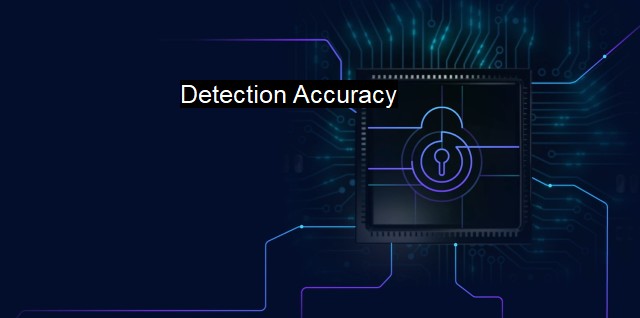What is Detection Accuracy?
Understanding Detection Accuracy in Cybersecurity and Antivirus: Effective Measures and Key Factors to Consider for Endpoint Security
In the field of cybersecurity and antivirus software, "detection accuracy" plays a pivotal role. It refers to the capability of an antivirus or cybersecurity solution to discover, recognize, and accurately identify known, unknown, or suspicious threats in the cybersecurity domain. Improved detection accuracy equates to a higher level of system and user protection, resulting in an enhanced trust factor of the concerned end-users towards the used solutions.In the highly dynamic and constantly evolving space of cybersecurity, detection accuracy is as complex as it is vital. Threats don't remain the same; they continually shift in shape, characterize new behaviors, and reveal diverse patterns. Consequently, an increased detection accuracy means the defence mechanisms can successfully discern such variations in threats, sharpen the protection, and temporarily or permanently mitigate the risk factor.
At a simpler level, detection accuracy could be understood in the light of two vital components: true positives and false positives. True positives refer to the instances where the antivirus software or cybersecurity solution successfully detects a real threat. On the other hand, false positives refer to the instances where the solution indicates a threat, but actually, there is none – in other words, a false alarm. An optimal balance between these two factors contributes to improved accuracy.
False positives are a major concern in maintaining high detection accuracy. Excessive warnings about potential threats that are non-existent can lead to frustration for users, waste system resources, and, most seriously, could lead to ignoring genuine threat signals. So, detection accuracy plays a crucial role in alleviating this issue, ensuring genuine threats are correctly detected while avoiding unneeded false alarms.
It is essential to note that an antivirus program or cybersecurity tool's detection accuracy is not measured by the mere ability to detect the maximum number of threats. It goes beyond just numerical strength. effectiveness in the identification of threats also factors in speed, efficiency, and the capacity to pick up fresh or emerging-threat instances. An ideal cybersecurity solution is the one that keeps up with the current threats in real-time and safeguards system devices and networks promptly with high detection accuracy.
Detection accuracy also counts on the smallest of details. Undetected threats, minuscule as they can be, could morph into lethal prospects. Precision in tracking down these minuscule threats adds further value to detection accuracy – the higher the detection rate, including the smallest and largest cyber threats, the better the antivirus or security solution.
In maximizing detection accuracy, there are scores of parameters to account for. Context-based factors such as the user's activities, background software processes, and network communication can affect detection accuracy. Software approaches like utilizing machine learning for behavior modelling, applying heuristics algorithms based on historical data, or implementing threat knowledge gained from global security intelligence can increase detection accuracy.
Efficient detection accuracy provides a vital basis for defending against cyber threats. Accuracy not only fortifies overall cybersecurity defences by recognizing threats of any manner or size and eliminating them rapidly but also provides users peace of mind. It ensures that their digital assets are safe, their privacy is preserved, and their productivity is undiminished.
Lastly, no antivirus solution promises 100% detection accuracy due to the ever-evolving nature of cyber threats. they continuously learn from past experiences and adopt newer means of protection, striding towards the best possible detection accuracy. Hence, detection accuracy stands at the spine of cybersecurity and antivirus armory and offers the much-needed sophistication to tackle the escalating complexity of modern-day cyber threats.

Detection Accuracy FAQs
What is detection accuracy in cybersecurity and antivirus?
Detection accuracy in cybersecurity and antivirus refers to the ability of the software to accurately identify and flag potential threats in a given system.How is detection accuracy calculated in cybersecurity and antivirus?
Detection accuracy is usually calculated by comparing the number of correctly identified threats to the total number of threats present in a system. A higher detection accuracy percentage indicates better performance of the software.What factors affect detection accuracy in cybersecurity and antivirus?
Several factors can affect detection accuracy in cybersecurity and antivirus, such as the complexity of the threat, the methods used by the software to detect threats, the frequency of software updates, and the level of user interaction required by the software.How can I improve detection accuracy in cybersecurity and antivirus?
To improve detection accuracy in cybersecurity and antivirus, it is recommended to use a combination of different antivirus and anti-malware software, keep all software up to date, use a reliable internet security suite, and avoid clicking on suspicious links or downloading unknown files. Regular system scans can also help to identify and remove potential threats.| | A | | | B | | | C | | | D | | | E | | | F | | | G | | | H | | | I | | | J | | | K | | | L | | | M | |
| | N | | | O | | | P | | | Q | | | R | | | S | | | T | | | U | | | V | | | W | | | X | | | Y | | | Z | |
| | 1 | | | 2 | | | 3 | | | 4 | | | 7 | | | 8 | | |||||||